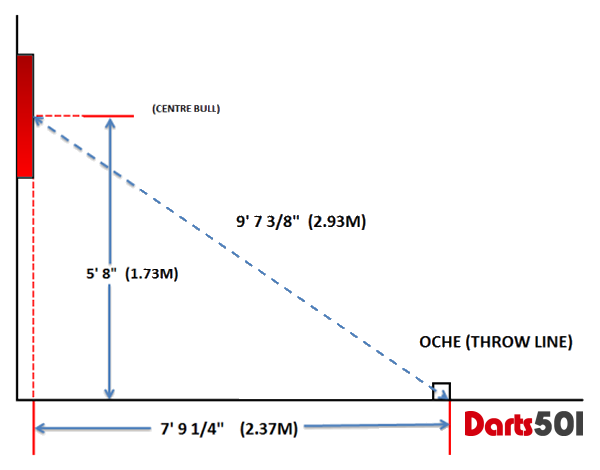
'01 Dart Games Rules and Variations
501,301,101,701,801,1,0001 - Dart Games
![]()
501, '01 Game
The ’01 game or as many know it today 501 has a standard set of rules adopted by BDO, WDF, PDC and more recently the WDDA. (See Disability Darts)
The object of this game is to reduce your score from 501 to exactly 0 with the last dart hitting double segment of the board or the bullseye.
The detail below gives you the full details on how to play ’01 game and variations that are sometimes adopted in professional dart competition and others that can be regionally endorsed in some pub leagues.
Dartboard Setup
The Board should hang securely from a wall so that the height of the centre bull is 5'8" or 1.73m from the floor.
The throwing distances can vary from anything from 7ft to 8'6" but the standard game is played from 7'9 ¼" 2.37m from the face of the board measured horizontally. For soft tip boards, the throwing distance is usually longer i.e. 8’ or 2.43m
The throw-line / toe-line or oche shall be clearly marked and should be at least 18" long. The throw line can be just a painted line on the ground or a securely raised line indicator such as a piece of wood or metal. The latter is preferable as the thrower has a firm edge to rest his/her foot against.

Steel-tip and Soft-tip Darts
Players can use any darts as long as the overall length of 30.5cms. (12") nor weigh more than 50 grams is exceeded. The dart should consist of a needle-shaped point, which shall be fixed to a barrel. At the rear of the barrel shall be an attached flighted shaft/stem, which may consist of up to five separate pieces. (IE: a flight, a flight securing device(s), a flight protector, and a stem.) For soft tip darts used on soft tip boards, most rules state that no dart heavier than 18 grams can be used otherwise the board can be damaged. Some soft tip boards can take heavier darts up to 24 grams but with heavier darts, you do tend to break more tips.
Order of Play
The order of play is either determined by a toss of a coin or by each player throwing for the centre bull the nearest being the player that throws first. The rules here can vary depending on the league you may be playing in; the local rules should be observed at all times.
When throwing for the bull, if the first thrower hits the centre bull or outer bull the dart is usually removed before the second player throws. If the second player hits the same as the first player then the bulling-up procedure starts again. If the first player's dart does not hit either the centre bull or outer bull then the dart remains in the board until the second player throws. If the first player's dart is obstructing the bull the second player may request the marker/ref to straighten the dart. (See local rules)
PDC ruling is different only the outer and inner bull count and all darts are removed after the throw. Should the first play throw and miss the inner or outer bull the dart is still retrieved. This is so the second player throwing does not have any obstruction or uses the dart in the dartboard to assist their own throw. Should the second player hit a bullseye or outer bullseyes they win the throw. Should he or she miss then this is considered a miss and both throw again. However, this time the person who threw second in the first attempt to determine who should throw first throw first.
I consider this method better and fairer. However, if you’re just playing a social game and not governed by organisation ruling you may find this method hard to use
Once the order of play has been determined the winner will start leg one and odd legs after that. The loser will start leg two and even legs thereafter.
A throw consists three darts except were the game is finished in less.
Darts cannot be re-thrown this includes darts that miss the board and darts that bounce of the board wiring system. Only darts that have their points touching the scoring area of the board score.
A player may be told, if he/she asks, what number they scored, or what number he requires for the game, by the score announcer, but not how to achieve it.
If the number required for the game is exceeded in the course of a throw, throw ceases, and no account is taken of the score obtained during that throw.
The inner bull (50) counts as double of (25) the outer bull.
The game is to score 701, 501 or 301 as previously agreed.
Scoring
Generally each player’s score must start and finish a game with a double (The outer narrow ring of the board). Competition games, however, are usually played with a straight start (no compulsory double) but with a compulsory double to finish.
The first throw is deducted from the player's start number e.g. 501 and then from the subsequently reduced total. The scorer should show both the score obtain for the throw and the reducing total remaining.
For fast Practice games play 301. For league and competition 501 and for pairs 701. In fact, any agreed starting number can be used but usually, the number should end 01 the reason for this is so a player must hit another part of the board other than the 20’s segment in order to win a game.
Alternative rules to ’01 games
Before 501 became the standard game played in most competitions, 301 was the main game played. 701,801 and 1,001 also feature in some leagues with the higher starting number sometimes played as a team game or beer leg. (the losing team buy the round!)
The ’01 game above is sometimes called straight start, double finish. However, there is an alternative to this and it is called a double start double finish. The player must start the game but first hitting any double or bullseye and missed dart to the point of hitting the double does not count. Example the players first dart might hit a single 20, the second a single twenty, the third a double twenty. The score is 40 (double twenty). The game continues as above and the player must hit the double to make his last score 0.
The biggest event that still uses this ruling is the PDC World Grand Prix.
Other rules (House Rules)
Double one becomes a favourite for the non-player because they always find themselves left on it after exhausting shots at other doubles. I once marked a game and I counted the number of darts it took for the game (leg) to be won, 98!
If you are new to the darts the one thing that can put you off is the double finish. So, if you and your opponent are of equal but not great ability, you might like to consider the following variation to the ’01 rules. It is called straight start, straight finish.
You do not need a double to start the game nor finish it, however, you do need to hit the exact score so you can bust your score. If you require 12 and hit a single twelve you win. You can also hit a double-six or treble-four as long as it equals the last remaining total.
Splitting the Elevens (House Rules)
If you find the games you play always seem to end up on double one and you hit a single one with the first or second dart, some rules (not common) allow you to throw the remaining dart/darts to split the number 11 effectively halving the ones! If you succeed you win! (House rules only)
Shanghai (House Rules)
There is a darts game called Shanghai but house rules will sometime allow you to win a game at any point by hitting a double, treble and single of the same number! Hmmmm… Well this isn’t the done thing but both sides need to agree before a dart is thrown
Regional variations
Regional variations or quirky rules as I sometimes call them. It is always best to first find out the local rules rather than to assume the format you have been playing is the same everywhere.
I have played darts all over the UK & Ireland and some areas, leagues can have some rules that you may not agree with and one such I came across is not being able to bust your last score!
The rules were designed to prevent a player busting deliberately so they were not left on a double they found difficult to hit. A basic example double-three or double-one are both considered not the easiest double to hit. The double three is at the base of the board and if you hit a single three, then you need to hit a one double-one. Should the game you are playing be one-sided and you find yourself a 200 in front you may try and set up your preferred finish, double-sixteen, double-ten but during your throw, things go wrong. You wanted 20 to win (double-ten) you hit big fifteen! 5 left, but your opponent can not finish they have too many points still to score, you decide to BUST the remaining five! But in this rule, you can’t! Hitting four or over would in normal rules make you last throw (throw of three darts) void and you will require 20 when you come back for another attempt! Not so here, the score you bust was 5! (last score) hence you will find yourself on 5 when you return!
I personally fell directly into this ‘trap’ when playing a social game in Somerset England. Not being aware of the ‘local’ rules I indeed busted a throw only to be told I was left on this number I had last busted. Busted indeed, not very happy with this rule, but I still managed to win and several more games after!
There are other dart ’01 variations I call ‘house rules’ because they are not considered rules at all just some quick to keep a game going. Some of these quicks, such as Shanghai have been made into games and splitting the elevens into loop/loopy. But personally, I keep to the standard rules without the quickie deviations.

If anyone says they use ‘gertcha’ rules, leave well alone!
Acknowledgements | Privacy, Cookies & Terms of Use | FAQ


